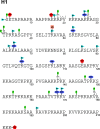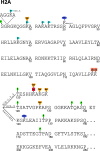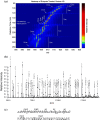The significance, development and progress of high-throughput combinatorial histone code analysis
- PMID: 20683756
- PMCID: PMC11115713
- DOI: 10.1007/s00018-010-0475-7
The significance, development and progress of high-throughput combinatorial histone code analysis
Abstract
The physiological state of eukaryotic DNA is chromatin. Nucleosomes, which consist of DNA in complex with histones, are the fundamental unit of chromatin. The post-translational modifications (PTMs) of histones play a critical role in the control of gene transcription, epigenetics and other DNA-templated processes. It has been known for several years that these PTMs function in concert to allow for the storage and transduction of highly specific signals through combinations of modifications. This code, the combinatorial histone code, functions much like a bar code or combination lock providing the potential for massive information content. The capacity to directly measure these combinatorial histone codes has mostly been laborious and challenging, thus limiting efforts often to one or two samples. Recently, progress has been made in determining such information quickly, quantitatively and sensitively. Here we review both the historical and recent progress toward routine and rapid combinatorial histone code analysis.
Figures








Similar articles
-
Combinations of histone post-translational modifications.Biochem J. 2021 Feb 12;478(3):511-532. doi: 10.1042/BCJ20200170. Biochem J. 2021. PMID: 33567070 Review.
-
Synthetic post-translational modification of histones.Curr Opin Chem Biol. 2018 Aug;45:35-47. doi: 10.1016/j.cbpa.2018.02.004. Epub 2018 Feb 28. Curr Opin Chem Biol. 2018. PMID: 29501025 Review.
-
Integrative Chemical Biology Approaches to Deciphering the Histone Code: A Problem-Driven Journey.Acc Chem Res. 2021 Oct 5;54(19):3734-3747. doi: 10.1021/acs.accounts.1c00463. Epub 2021 Sep 23. Acc Chem Res. 2021. PMID: 34553920 Review.
-
A brief histone in time: understanding the combinatorial functions of histone PTMs in the nucleosome context.Biochem Cell Biol. 2016 Feb;94(1):33-42. doi: 10.1139/bcb-2015-0031. Epub 2015 Jun 3. Biochem Cell Biol. 2016. PMID: 26197985 Review.
-
The top-down, middle-down, and bottom-up mass spectrometry approaches for characterization of histone variants and their post-translational modifications.Proteomics. 2014 Mar;14(4-5):489-97. doi: 10.1002/pmic.201300256. Epub 2013 Dec 16. Proteomics. 2014. PMID: 24339419 Review.
Cited by
-
Quantitative proteomic analysis of histone modifications.Chem Rev. 2015 Mar 25;115(6):2376-418. doi: 10.1021/cr500491u. Epub 2015 Feb 17. Chem Rev. 2015. PMID: 25688442 Free PMC article. Review. No abstract available.
-
The Impact of Alcohol-Induced Epigenetic Modifications in the Treatment of Alcohol use Disorders.Curr Med Chem. 2024;31(36):5837-5855. doi: 10.2174/0109298673256937231004093143. Curr Med Chem. 2024. PMID: 37828672 Review.
-
Effects of acute heat stress on protein expression and histone modification in the adrenal gland of male layer-type country chickens.Sci Rep. 2021 Mar 22;11(1):6499. doi: 10.1038/s41598-021-85868-1. Sci Rep. 2021. PMID: 33753796 Free PMC article.
-
Examining histone posttranslational modification patterns by high-resolution mass spectrometry.Methods Enzymol. 2012;512:3-28. doi: 10.1016/B978-0-12-391940-3.00001-9. Methods Enzymol. 2012. PMID: 22910200 Free PMC article.
-
Regulation of Histone Acetylation Modification on Biosynthesis of Secondary Metabolites in Fungi.Int J Mol Sci. 2024 Dec 24;26(1):25. doi: 10.3390/ijms26010025. Int J Mol Sci. 2024. PMID: 39795886 Free PMC article. Review.
References
-
- Luger K, Mader AW, Richmond RK, Sargent DF, Richmond TJ. Crystal structure of the nucleosome core particle at 2.8 A resolution. Nature. 1997;389(6648):251–260. - PubMed
-
- Prohaska SJ, Stadler PF, Krakauer DC. Innovation in gene regulation: the case of chromatin computation. J Theor Biol. 2010;265(1):27–44. - PubMed
-
- Jenuwein T, Allis CD. Translating the histone code. Science. 2001;293(5532):1074–1080. - PubMed
-
- Strahl BD, Allis CD. The language of covalent histone modifications. Nature. 2000;403(6765):41–45. - PubMed
-
- Kouzarides T. Chromatin modifications and their function. Cell. 2007;128(4):693–705. - PubMed
Publication types
MeSH terms
Substances
Grants and funding
LinkOut - more resources
Full Text Sources
Miscellaneous

